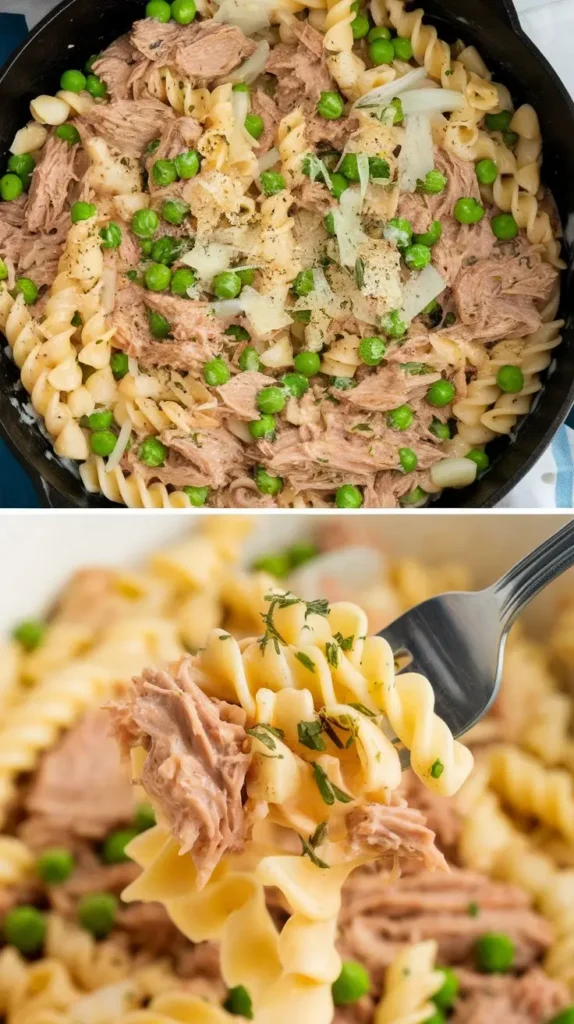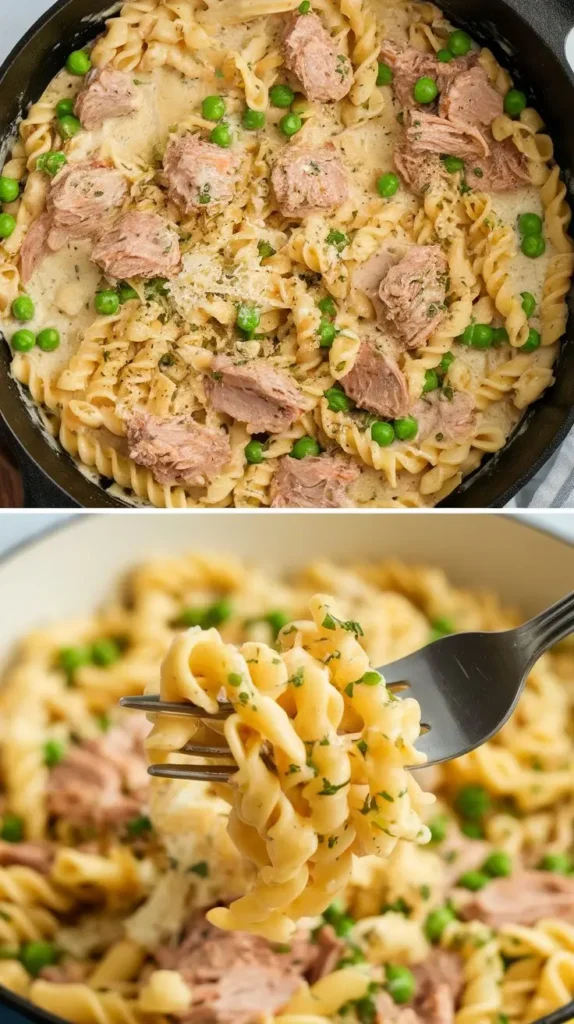What Makes Tuna Pasta a Consistent Winner in the Modern Kitchen?
Did you know that over 60% of home cooks turn to pantry-based recipes at least once a week? Tuna pasta is a prime example of this culinary trend, combining convenience with flavor and nutrition. Contrary to its reputation as a college-dorm staple or a last-minute meal, a thoughtfully crafted tuna pasta can rival much more labor-intensive dishes in both taste and sophistication. With the right ingredients and techniques, you can elevate tuna pasta into a memorable experience—one that’s hearty, impressive, and packed with omega-rich goodness. Let’s dig into how this humble dish can transform any dinner table.
Ingredients List
A truly elevated tuna pasta balances briny richness with layers of complexity. Here’s what you’ll need:
- High-quality canned tuna (in olive oil preferred): The richness from oil-packed tuna delivers depth, but water-packed works for a lighter version.
- Pasta (spaghetti, penne, or fusilli): Use whole wheat or gluten-free pasta for dietary adjustments.
- Cherry tomatoes: Adds a burst of sweetness and color.
- Capers: For that essential salty tang.
- Kalamata olives (pitted and chopped): Bring in a Mediterranean dimension.
- Garlic (minced): A fragrant backbone for every mouthful.
- Red onion or shallots: Choose shallots for a subtler, sweeter tone.
- Lemon zest and juice: Brightens the dish and balances the umami.
- Fresh parsley (chopped): Offers color and a hint of earthiness.
- Crushed red pepper flakes: For gentle heat.
- Extra-virgin olive oil: Use the best you have on hand.
- Salt and pepper: Season to taste.
For optional upgrades:
- Fresh baby spinach or arugula: Stir in for extra greens.
- Parmesan cheese: A sprinkle just before serving brings savory depth.
- Anchovy fillets: For serious umami lovers, melt one or two with the garlic.
Substitution Ideas:
- Switch out olives with sun-dried tomatoes for a different zing.
- Use canned salmon or mackerel for an adventurous twist.
- Try gluten-free or legume-based pasta for added protein or specific dietary needs.
Timing
Tuna pasta is an ideal weekday choice, coming together quickly without sacrificing richness.
| Step | Time (minutes) |
|---|---|
| Prep | 8 |
| Cooking | 14 |
| Total Time | 22 |
This puts the recipe at roughly 20% less time than the average pasta dish that includes a simmered sauce. Your meal gets to the table faster without feeling rushed or skimpy.

Step-by-Step Instructions
Step 1: Prep and Boil the Pasta
Bring a large pot of salted water to a rolling boil. Use at least four quarts per pound of pasta for even cooking and plenty of room. Drop in your pasta and stir often at first to prevent sticking.
Tip: Do not overcook! Pull the pasta a minute before fully al dente. It will continue cooking slightly when mixed with the sauce.
Step 2: Build the Base
While the pasta cooks, heat a generous splash of extra-virgin olive oil in a wide skillet over medium heat. Add minced garlic and red onion (or shallots). Stir constantly for that gentle fragrance—about two minutes, just until golden and soft.
If using anchovy fillets, let them melt into the oil during this stage for unmatched savory power.
Step 3: Create Depth
Add cherry tomatoes, capers, and olives to the skillet. Saute for four to five minutes. The tomatoes should start to collapse, their juices forming a light sauce with the oil.
Sprinkle over the crushed red pepper flakes for a gentle kick, or leave them out for a milder dish.
Step 4: Introduce Tuna
Drain the tuna well and gently flake it into the pan. Lower the heat, tossing to coat. Let it warm through without drying out.
Squeeze in fresh lemon juice and a shower of zest—this little burst of citrus will lift and unify the flavors.
Step 5: Finish and Combine
When the pasta is ready, reserve a cup of pasta water before draining. Add the pasta to the skillet, tossing everything together. If it feels dry, pour in splashes of reserved pasta water. This silky starch blend brings everything together beautifully.
Finish with chopped fresh parsley and, if you like, a dusting of Parmesan.
Tip: Letting the pasta sit in the pan for a minute helps meld the flavors for a restaurant-quality bite.
Nutritional Information
Tuna pasta can be as light or as hearty as you wish, depending on your chosen ingredients and serving size. Here’s a nutritional snapshot for a standard serving (with 2 oz dry pasta, 3 oz tuna, and typical veggies):
| Nutrient | Amount per Serving | % Daily Value (est.) |
|---|---|---|
| Calories | 410 | 20% |
| Protein | 27g | 54% |
| Carbs | 48g | 16% |
| Fat | 12g | 18% |
| Fiber | 6g | 24% |
| Omega-3s | 650mg | 40% |
| Sodium | 600mg | 25% |
| Calcium | 80mg | 8% |
| Iron | 3mg | 20% |
- Excellent source of lean protein and long-chain Omega-3s.
- Can be low in saturated fat if using tuna packed in water.
- Vegetables and whole grain pasta boost fiber content.
Healthier Alternatives for the Recipe
Lighter, brighter, or more plant-forward versions are easy to create without giving up any enjoyment:
- Whole wheat, chickpea, or lentil pasta: Add both fiber and protein, making the dish extra filling.
- Reduce sodium: Use low-salt tuna and rinse the capers/olives before adding.
- Bulk up on veggies: Double the tomatoes and greens, or add zucchini ribbons or chopped artichoke hearts.
- Dairy-free: Omit Parmesan or use a cashew-based vegan cheese.
- Mediterranean twist: Serve with diced cucumbers and fresh mint for a cooling effect.
- Low-carb: Swap pasta for spiralized zucchini or hearts of palm noodles.
Dietary customization is simple—think about what personal or family needs matter most, and swap accordingly.
Serving Suggestions
Tuna pasta can be styled for cozy weeknights or sophisticated gatherings. Consider these serving ideas:
- Scatter toasted pine nuts on each plate for crunch.
- Serve atop a bed of lightly dressed arugula for a peppery counterbalance.
- Pair the dish with a crisp white wine—Sauvignon Blanc or Vermentino works beautifully.
- For a hearty dinner, offer a side of rustic bread and a green salad with lemon vinaigrette.
- Pack leftovers into individual containers with extra fresh herbs for quick, elevated lunches.
If you like, finish each serving with a drizzle of your fanciest olive oil and an extra grind of black pepper for that true “chef’s touch.”
Common Mistakes to Avoid
Even such a simple dish demands a little care. Watch for these slip-ups:
- Overcooking the pasta: Remember it will continue to cook in the pan. Undercook by 1-2 minutes for the right texture.
- Using poor-quality tuna: Opt for sustainably sourced, high-quality tuna whenever possible. Avoid mushy or overly fishy brands.
- Drowning the dish in mayo or heavy sauces: The oil and lemon juice provide all the silkiness you need—heavy sauces can mask the brighter flavors.
- Ignoring pasta water: That starchy water helps the sauce cling to every strand.
- Letting tuna dry out: Add it last, heat gently, and combine with the other ingredients rather than simmering it to death.
- Fear of seasoning: Taste as you go—be generous with fresh herbs, lemon, and black pepper.
Experiential Advice
A little restraint goes a long way. This recipe thrives on balance rather than excess.
Storing Tips for the Recipe
Preserving freshness and flavor is simple with a few thoughtful habits:
- Refrigerate leftovers promptly in an airtight container; the flavors often intensify overnight.
- Store up to three days: Beyond that, both the pasta and tuna can become less appealing.
- Reheat with care: A splash of water or olive oil before microwaving helps restore texture.
- Freeze only if necessary: Tuna pasta can be frozen, but the texture may shift slightly. Portion into serving-size containers and thaw gently.
Prep ahead: Chop vegetables, zest lemons, and measure ingredients the night before for breezy assembly.
Conclusion
A refined tuna pasta doesn’t just satisfy hunger; it delights the senses with bold flavors, bright herbs, and a mix of textures. Here’s your chance to turn a classic into something special—try it tonight, share your thoughts in our review section or comment on the blog, and subscribe if you’d love more inspiring recipes for every season!
FAQs
How can I keep tuna pasta from tasting bland? Use quality tuna, layer plenty of lemon, herbs, and capers, and never skip seasoning with salt and fresh pepper. Pasta water is your friend.
Can I serve this dish cold? Yes! This recipe works beautifully as a chilled pasta salad. Use short pasta shapes and add extra veggies or beans for substance.
Is this safe for kids? Definitely. Omit the red pepper flakes for young palates, and be mindful of sodium if your tuna or olives are particularly salty.
What wine pairs best with tuna pasta? Crisp whites such as Vermentino, Pinot Grigio, or even a dry Rosé highlight the citrus and herbal notes in the dish.
I’m not a fan of olives or capers. What else can I use? Try sun-dried tomatoes, roasted red peppers, or even artichoke hearts for a different twist that still delivers a savory punch.
Thirsty for more practical cooking insights? Check out our archives for additional weeknight favorites, or sign up for updates to never miss fresh ideas!


